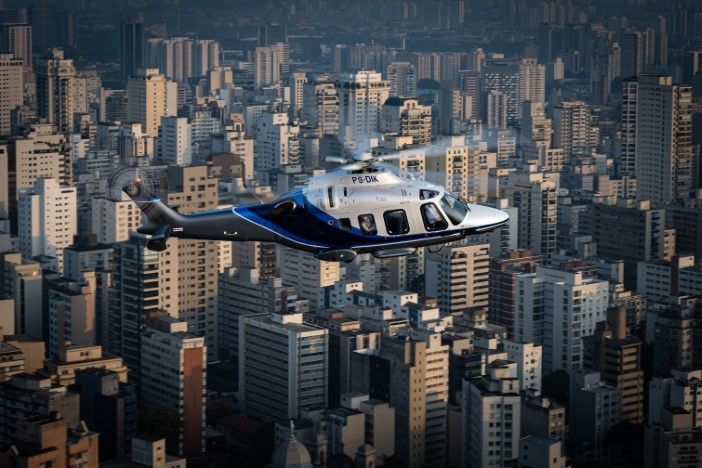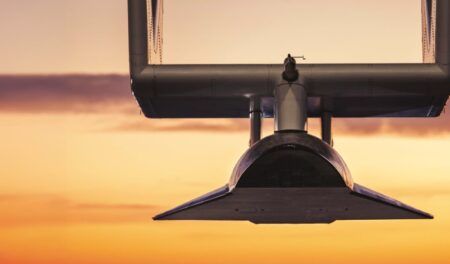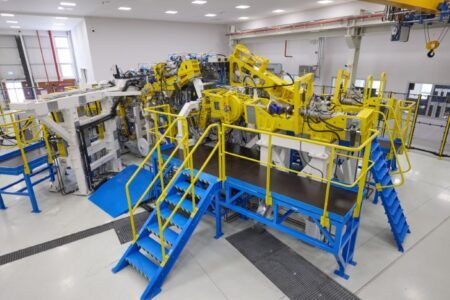Leonardo Helicopters has achieved a significant advance in flight testing efficiency by developing a new quasi-steady acceleration methodology. The technique is used during performance testing for helicopters and slashes flight test times from around 45 to just six minutes, while maintaining comparable accuracy to traditional methods.
The innovative approach was presented at the Society of Flight Test Engineers (SFTE) European Chapter Conference in Prague in June and won the best paper award. The method is a fundamental shift from conventional steady-state testing to dynamic acceleration-based performance evaluation.
TIME SAVINGS
The quasi-steady level acceleration test technique delivers an 88% reduction in flight time compared to traditional steady-state methods. It was developed by a team from Leonardo Helicopters and the department of aerospace science and technology at the Politecnico di Milano, Italy.
“The slowest acceleration that we tested, 0.22 knots per second, guaranteed a huge reduction in time compared to the traditional methodology required by the traditional flight test technique – about an 85% saving,” said Irene Salmoiraghi, flight test engineer, Leonardo Helicopters, speaking at the SFTE conference.
Traditional helicopter performance testing requires multiple precisely stabilized flight conditions across various airspeeds. Each test point demanding one to two minutes of stabilized flight. The new quasi-steady method replaces these discrete points with a single continuous acceleration run performed at a carefully controlled rate.
The starting point for developing the quasi-steady method was the realization that the fundamental differences in rotorcraft control dynamics meant that using conventional fixed-wing aircraft-level acceleration testing techniques was unsuitable for helicopters.
Andrea Castelli, head of flight test engineering at Leonardo Helicopters, explains, “We have a main rotor – just one component managing the vertical power. So the vertical control of the aircraft and the power are the same object. The rotor also acts as a control surface with the cyclic control to accelerate.”
This coupling between altitude control and power management, combined with tail rotor dynamics, prevents the flight test team from maintaining maximum continuous power throughout acceleration runs, a key aspect of fixed-wing testing protocols.
“During an acceleration run, the airspeed increase leads to an increase in the vertical tail lifting force, which generates a bigger anti-torque moment,” the researchers note. “Therefore, the recorded torque decreases with increasing speed at fixed collective position.”
DATA ANALYSIS
The team developed a specialized data analysis procedure that accounts for the dynamic nature of the quasi-steady tests. The methodology incorporates correction terms for both altitude variations and airspeed changes, building on the fundamental relationship between power required, power available, and specific excess power.
The analysis applies the formula: “Power Required = Power Available – Power Associated with Altitude Variations – Power Associated with Airspeed Variations”.
This approach allows engineers to extract accurate power-required curves from continuous acceleration data rather than discrete stabilized points.
The other key enabler of the quasi-steady methodology involves the creative use of the existing helicopter flight director systems. The researchers found that by engaging both the altitude hold and indicated airspeed modes simultaneously they achieved the optimal balance of control authority and pilot workload reduction.
“The use of the flight director, in particular the use of the altitude and indicated airspeed modes, turned out to be the easiest way to accomplish the goal,” Salmoiraghi says.
The altitude mode maintains reference altitude through collective control inputs, while the airspeed mode is manipulated to create steady acceleration rather than constant speed. This enables pilots to achieve consistent acceleration rates of approximately 0.22 knots per second – the optimal balance between accuracy and efficiency identified through extensive testing.

FLIGHT VALIDATION
The development process began with comprehensive simulation testing using the AW169 Virtual Development Environment, before progressing to flight validation. The simulation environment allowed the team to refine the procedures and data analysis techniques cost-effectively before committing to flight test hours.
Castelli emphasizes the simulation’s role: “The use of the artificial flight environment played a key role in the development of this work. It permitted us to gain familiarity with the testing procedures and to fine-tune the flying and the data analysis.”
Real-world flight testing was then done to confirm the simulation results, with mean deviations of just seven shaft horsepower, representing a less than 1.5% error margin compared to traditional methods.
Leonardo has already integrated the new methodology into its flight test handbook and design organization systems. “We are going to use it because it saves so much time,” Castelli says.
“We’re increasingly leveraging development simulation and testing environments as they’re also incrementally allowing lower technology risk, greater safety and greater sustainability – both environmentally and financially speaking.”
The efficiency gains are particularly valuable for evaluating equipment modifications to helicopters. Traditional kit impact assessments typically requires five different flights, but the use of the new technique enables five power curve evaluations within a single flight.
REGULATORY CONSIDERATIONS
The team is talking with aviation authorities about gaining acceptance for the new methodology.
“We are also duplicating the test, so we do the traditional one, and in the same flight, we do the acceleration,” Castelli says. This parallel approach will allow Leonardo to build confidence with regulators while maintaining compliance with existing requirements.
The quasi-steady methodology does have limitations and only applies specifically to acceleration runs. Deceleration tests consistently exceeded acceptable deviation ranges. The team also identifies the need for sophisticated flight test instrumentation systems, though Castelli notes that the development of AI-based acquisition systems could extend the use of the technique to production aircraft.
Future research will investigate helicopter pitch attitude effects on power curve accuracy and expand testing to different aircraft configurations. “We need to test it on different helicopters,” Castelli acknowledges. “Maybe heavy aircraft have different dynamics, if and when necessary we’ll have to assess.”
INDUSTRY IMPACT
Helicopter development programs face increasing cost and schedule pressures. The quasi-steady acceleration technique addresses the need for more efficient flight testing that maintains technical accuracy while dramatically reducing test time.
The research demonstrates how the creative application of existing helicopter systems, combined with clever data analysis, can unlock significant efficiency improvements without requiring new hardware or major procedural changes. It shows that traditional assumptions about flight test requirements can be challenged through innovative engineering approaches.
The significant time reduction achieved establishes a new benchmark for helicopter flight test efficiency and innovation.
The paper “Level Acceleration Flight Test Methodologies for Helicopter Performance Evaluation” by Irene Salmoiraghi, Andrea Castelli, Christopher Hyder (all from Leonardo Helicopters) and Lorenzo Trainelli, associate professor of the department of aerospace science and technology at the Politecnico di Milano (DAER) is available from the Society of Flight Test Engineers website. Become a member of the SFTE to view the paper here.





